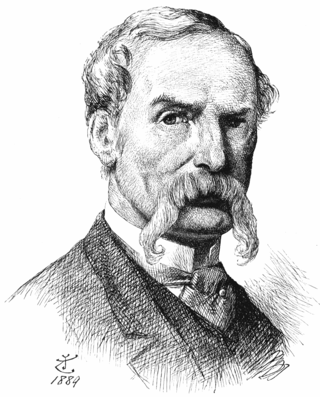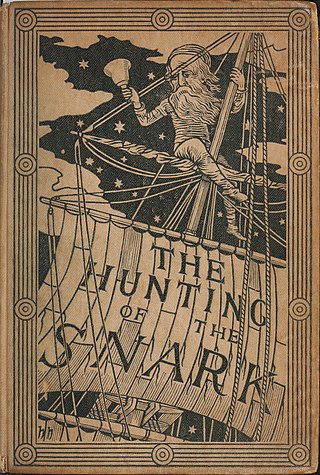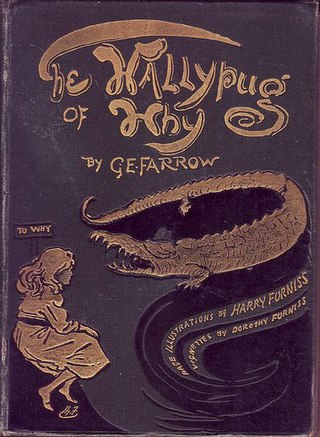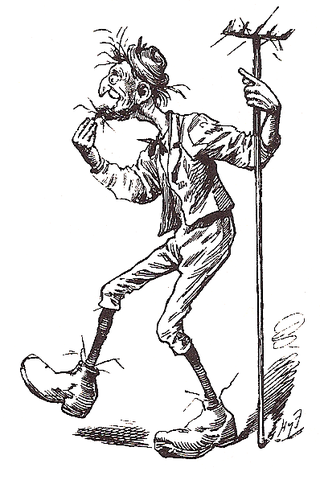
Sir John Tenniel was an English illustrator, graphic humourist and political cartoonist prominent in the second half of the 19th century. An alumnus of the Royal Academy of Arts in London, he was knighted for artistic achievements in 1893, the first such honour ever bestowed on an illustrator or cartoonist.

"Jabberwocky" is a nonsense poem written by Lewis Carroll about the killing of a creature named "the Jabberwock". It was included in his 1871 novel Through the Looking-Glass, the sequel to Alice's Adventures in Wonderland (1865). The book tells of Alice's adventures within the back-to-front world of the Looking-Glass world.

The Hunting of the Snark, subtitled An Agony, in Eight fits, is a poem by the English writer Lewis Carroll. It is typically categorised as a nonsense poem. Written between 1874 and 1876, it borrows the setting, some creatures, and eight portmanteau words from Carroll's earlier poem "Jabberwocky" in his children's novel Through the Looking-Glass (1871).

Alice's Adventures in Wonderland is an 1865 English children's novel by Lewis Carroll, a mathematics don at the University of Oxford. It details the story of a girl named Alice who falls through a rabbit hole into a fantasy world of anthropomorphic creatures. It is seen as an example of the literary nonsense genre. The artist John Tenniel provided 42 wood-engraved illustrations for the book.

Thomas Hood was an English humorist, playwright and author. He was the son of the poet and author Thomas Hood. Pen and Pencil Pictures (1857) was the first of his illustrated books. His most successful novel was Captain Master's Children (1865).

Harry Furniss was a British illustrator. He established his career on the Illustrated London News before moving to Punch. He also illustrated Lewis Carroll's novel Sylvie and Bruno.
"On Exactitude in Science", or "On Rigor in Science" is a one-paragraph short story by Argentine writer Jorge Luis Borges.

"The Walrus and the Carpenter" is a narrative poem by Lewis Carroll that appears in his book Through the Looking-Glass, published in December 1871. The poem is recited in chapter four, by Tweedledum and Tweedledee to Alice.

Sylvie and Bruno, first published in 1889, and its second volume Sylvie and Bruno Concluded published in 1893, form the last novel by Lewis Carroll published during his lifetime. Both volumes were illustrated by Harry Furniss.

An unbirthday is an event celebrated on all days of the year which are not a person's birthday. It is a neologism which first appeared in Lewis Carroll's 1871 novel Through the Looking-Glass. The concept gave rise to "The Unbirthday Song" in the 1951 animated feature film Alice in Wonderland.
The Lewis Carroll Shelf Award was an American literary award conferred on several books by the University of Wisconsin–Madison School of Education annually from 1958 to 1979. Award-winning books were deemed to "belong on the same shelf" as Alice's Adventures in Wonderland and Through the Looking-Glass by Lewis Carroll, having enough of the qualities of his work.
"How Doth the Little Crocodile" is a poem by Lewis Carroll which appears in chapter 2 of his 1865 novel Alice's Adventures in Wonderland. Alice recites it while attempting to recall "Against Idleness and Mischief" by Isaac Watts. It describes a crafty crocodile that lures fish into its mouth with a welcoming smile.

"'Tis the Voice of the Lobster" is a poem by Lewis Carroll that appears in Chapter 10 of his 1865 novel Alice's Adventures in Wonderland. It is recited by Alice to the Mock Turtle and the Gryphon.
"All in the golden afternoon" is the preface poem in Lewis Carroll's 1865 book Alice's Adventures in Wonderland. The introductory poem recalls the afternoon that he improvised the story about Alice in Wonderland while on a boat trip from Oxford to Godstow, for the benefit of the three Liddell sisters: Lorina Charlotte, Alice Pleasance, and Edith Mary. Alice gave her name to Carroll's main character.
"You Are Old, Father William" is a poem by Lewis Carroll that appears in his 1865 book Alice's Adventures in Wonderland. It is recited by Alice in Chapter 5, "Advice from a Caterpillar". Alice informs the Caterpillar that she has previously tried to repeat "How Doth the Little Busy Bee" and has had it all come wrong as "How Doth the Little Crocodile". The Caterpillar asks her to repeat "You Are Old, Father William", and she recites it.

The Wallypug of Why is an 1895 children's novel by G. E. Farrow. The book is an exercise in humorous nonsense, rich in wordplay and absurd situations, in the tradition of Lewis Carroll's Alice's Adventures in Wonderland. A popular success, it inaugurated a series of Wallypug sequels.

Charles Lutwidge Dodgson, better known by his pen name Lewis Carroll, was an English author, poet, mathematician and photographer. His most notable works are Alice's Adventures in Wonderland (1865) and its sequel Through the Looking-Glass (1871). He was noted for his facility with word play, logic, and fantasy. His poems Jabberwocky (1871) and The Hunting of the Snark (1876) are classified in the genre of literary nonsense.

Isa Bowman (1874–1958) was an actress, a close friend of Lewis Carroll and author of a memoir about his life, The Story of Lewis Carroll, Told for Young People by the Real Alice in Wonderland.

"The Mock Turtle's Song", also known as the "Lobster Quadrille", is a song recited by the Mock Turtle in Lewis Carroll's 1865 novel Alice's Adventures in Wonderland, accompanied by a dance. It was taught to him at school by his teacher called Tortoise.

"The Mad Gardener's Song" is a poem by Lewis Carroll that appears in his book Sylvie and Bruno.














